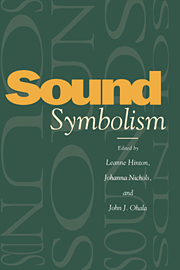Book contents
- Frontmatter
- Contents
- List of contributors
- 1 Introduction: Sound-symbolic processes
- PART I Native American languages north of Mexico
- PART II Native languages of Latin America
- PART III Asia
- PART IV Australia and Africa
- PART V Europe
- PART VI English
- 18 Phonosyntactics
- 19 Aural images
- 20 Inanimate imitatives in English
- PART VII The biological bases of sound symbolism
- Index
18 - Phonosyntactics
Published online by Cambridge University Press: 04 August 2010
- Frontmatter
- Contents
- List of contributors
- 1 Introduction: Sound-symbolic processes
- PART I Native American languages north of Mexico
- PART II Native languages of Latin America
- PART III Asia
- PART IV Australia and Africa
- PART V Europe
- PART VI English
- 18 Phonosyntactics
- 19 Aural images
- 20 Inanimate imitatives in English
- PART VII The biological bases of sound symbolism
- Index
Summary
Introduction
Although the search for linguistic universals has been successful in discovering a wide variety of similarities among the languages of the world (Greenberg 1966, 1978), few generalities about the semantic properties of languages have been uncovered (Weinreich 1963). Some of the most striking examples of a structured semantic domain are to be found in the connection between sound and meaning. In principle, resemblances between meaning and sound should not exist. As Greenberg (1957) notes, the connection between sound and meaning is essentially arbitrary. A meaning can theoretically be represented by almost any set of sounds in a language.
Despite claims that this principle applies to all languages, the articles in this volume show that connections between the meanings and the sounds of language do exist. Two universal and well-documented cases of sound symbolism are relevant to the present study. First, Ultan (1978) found evidence for distance symbolism. The notion of distance symbolism must be considered within the broader framework of deixis. Deixis refers to those features of the language which reflect the spatio-temporal coordinates of the relative situation of the utterance. Distinctions are made between things that are near in space and/or time versus things that are far in space and/or time. In an analysis of 136 languages, Ultan found that 33.1% of the sample exhibited distance (spatial) symbolism in their demonstrative system. More importantly, the languages that overtly symbolized distance relationships predominantly used front or high front vowels to represent proximity to the speaker. Ultan also found universal correspondences for size symbolism in language. Some languages overtly mark words expressing diminution by changing the phonological features of the sound in the root.
- Type
- Chapter
- Information
- Sound Symbolism , pp. 263 - 275Publisher: Cambridge University PressPrint publication year: 1995
- 4
- Cited by



